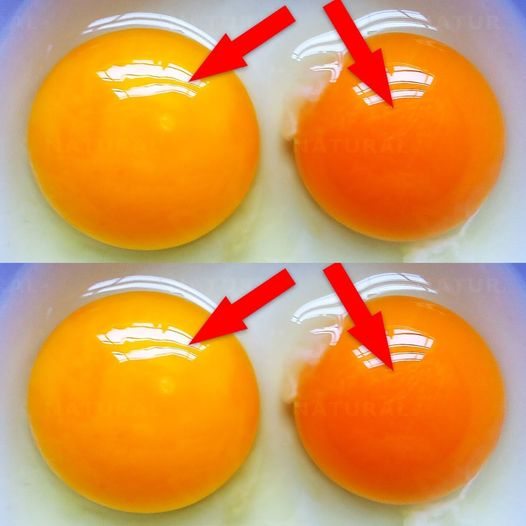ADVERTISEMENT
**What the Color of Your Egg Yolk Means: A Guide to Understanding Egg Quality**
Eggs are a staple in kitchens worldwide, known for their versatility and nutritional benefits. But have you ever wondered why some egg yolks are deep yellow while others are pale or even orange? The color of an egg yolk can actually tell you quite a bit about the egg itself, from the hen’s diet to its overall health. While the yolk color might seem like a minor detail, it can offer valuable insights into the quality and freshness of the egg.
In this article, we’ll dive into what the color of your egg yolk means and how it affects the flavor, nutrition, and cooking properties of your eggs. Let’s crack open the mystery behind egg yolk color and explore its significance.
—
### **Factors That Influence Egg Yolk Color**
Before we get into what the color of the yolk indicates, it’s important to understand what causes these variations. The color of an egg yolk is primarily influenced by the hen’s diet and genetics. Here’s a breakdown of the key factors:
1. **Hen’s Diet**
The most significant factor affecting yolk color is what the hen eats. Chickens that are fed a diet rich in yellow or orange plant pigments, like **marigold petals**, **corn**, or **alfalfa**, tend to produce eggs with deeper yellow or orange yolks. On the other hand, hens fed a diet with less pigment, such as a grain-based diet, will produce eggs with lighter yolks.
2. **Type of Feed**
Hens that are fed natural foods, such as **grasses** and **bugs**, often produce eggs with richer yolks. These free-range or pasture-raised chickens have access to a varied diet, which results in more intense yolk colors. Hens raised in conventional systems are typically fed commercial feed, which may not contain as many colorful pigments, leading to paler yolks.
3. **Genetics**
While diet plays the most significant role in yolk color, genetics also has an influence. Some chicken breeds, such as **Rhode Island Reds** or **Australorps**, are more likely to produce darker yolks due to their genetic makeup.
4. **Freshness**
The color of the yolk can also be impacted by the freshness of the egg. Fresher eggs tend to have firmer, more vibrant yolks, while older eggs may have softer, paler yolks due to the breakdown of proteins in the egg over time.
—
### **What the Color of Your Egg Yolk Means**
Now that we understand the key factors influencing yolk color, let’s look at what the different colors might signify:
#### **1. Pale Yellow Yolk**
**What it means:**
Eggs with pale yellow yolks often come from hens fed a basic diet, such as **grain-based feed**, which lacks the carotenoids responsible for richer yolk colors. These eggs are often produced by factory-farmed chickens.
**Impact on taste and nutrition:**
While pale yellow yolks are not harmful, they tend to be less nutrient-dense compared to darker yolks. The flavor may also be more neutral, lacking the robust richness that some people associate with farm-fresh eggs.
**Best for:**
Pale yellow yolks are commonly found in **store-bought eggs** and are perfectly fine for everyday use in baking, scrambled eggs, and omelets. Their flavor may be more subtle, but they still provide the same essential nutrients.
—
#### **2. Bright Yellow Yolk**
**What it means:**
Bright yellow yolks are often seen in eggs from hens that are fed a diet with some added **corn** or **alfalfa**. These hens might be kept in cages, but their feed is usually supplemented with natural pigments that deepen the yolk color.
**Impact on taste and nutrition:**
Bright yellow yolks indicate a more balanced diet for the hens, which can enhance the flavor and nutritional value of the egg. While these yolks are not as nutrient-dense as deeper yellow or orange yolks, they still provide a good amount of protein and healthy fats.
**Best for:**
Eggs with bright yellow yolks are suitable for most culinary uses, including frying, baking, and boiling. They provide a balance of flavor, color, and nutrition, making them ideal for everyday meals.
—
#### **3. Deep Yellow or Orange Yolk**
**What it means:**
Deep yellow or orange yolks are a clear indication that the hen has been fed a diet rich in **carotenoids**, which are pigments found in plants like **marigolds** or **yellow corn**. These yolks are often produced by hens that are either **free-range** or **pasture-raised**, having access to grass, seeds, and insects.
**Impact on taste and nutrition:**
Deep yellow or orange yolks typically offer a richer, more intense flavor. These eggs are also packed with more **omega-3 fatty acids**, **vitamins A** and **D**, and **antioxidants**. They tend to have a firmer texture and are often considered higher quality due to their diet, which leads to greater nutritional density.
**Best for:**
These eggs are perfect for showcasing their vibrant yolks in dishes like **fried eggs**, **poached eggs**, or **egg salad**, where the yolk’s rich color and flavor can truly shine. They are also ideal for making **custards** or **mayonnaise**, where the yolk is the star of the dish.
For Complete Cooking STEPS Please Head On Over To Next Page Or Open button (>) and don’t forget to SHARE with your Facebook friends
ADVERTISEMENT
